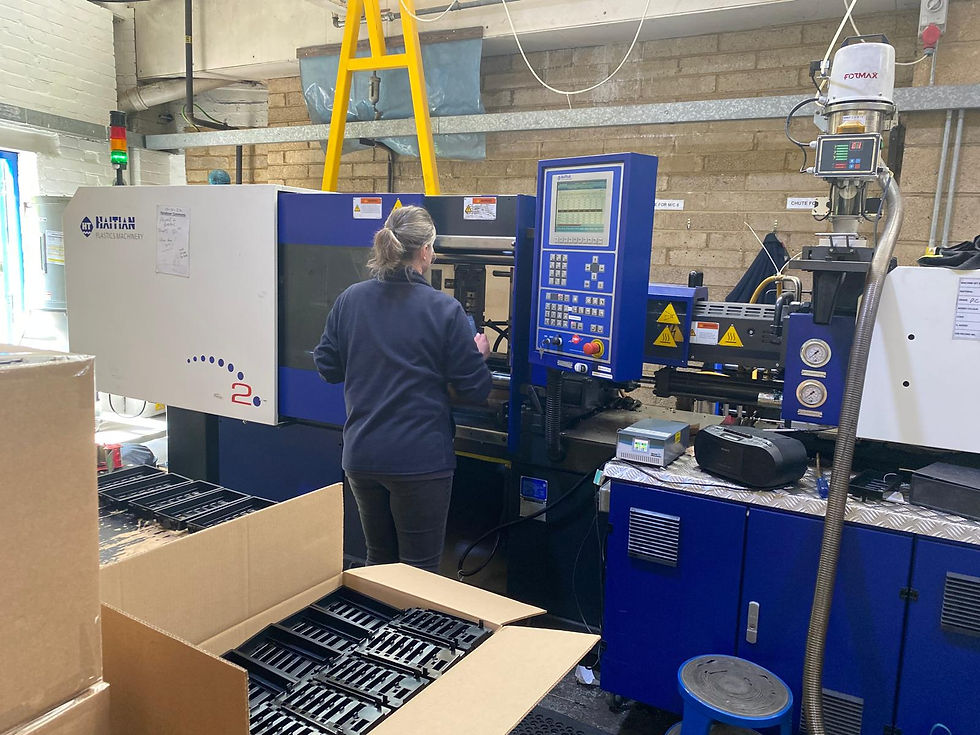Journey through Injection Moulding: Plastic Injection Moulding Types
- alisonpitt
- May 3, 2024
- 3 min read
Updated: Jul 5, 2024
Injection moulding stands as a cornerstone in the realm of plastic manufacturing, offering a plethora of techniques catering to diverse needs and applications. At its core, injection moulding involves the meticulous injection of molten polymers into specially crafted moulds, resulting in an array of structurally sound plastic parts. This versatile method finds its niche across industries, from crafting toys to engineering automotive components. Let's delve into the intricacies of some prominent moulding types that shape our plastic world.
Conventional Injection Moulding: As the undisputed champion of plastic manufacturing, conventional injection moulding reigns supreme. This method involves injecting molten plastic into meticulously crafted mould cavities, yielding a vast array of products with precision and efficiency. From intricate components in electronics to durable automotive parts, conventional injection moulding remains the go-to choice for manufacturers worldwide.

Blow Moulding: Blow moulding shares similarities with injection moulding yet diverges in its execution. Molten plastic is poured vertically from a barrel, guided by a specialized tube into the mould. Upon mould closure, the plastic expands outward, coating the interior to assume the desired shape. Subsequent cooling leads to the formation of a hollow interior, rendering blow moulding ideal for crafting bottles, food containers, and tubes.
Structural Foam Moulding: is frequently chosen for applications requiring enhanced durability and tensile strength, making it particularly suitable for items with thicker walls. By introducing a small amount of nitrogen or chemical blow agent into the molten plastic, its consistency is thickened. As the mixture enters the mould, it undergoes foaming, creating a solidified plastic skin that forms the item's wall. This method is compatible with various thermoplastics capable of undergoing injection moulding processes.
Thermoforming: Thermoforming presents a distinctive approach compared to injection moulding and other plastic melting methods. Pre-extruded, rigid plastic sheets undergo heating and are drawn into hollowed-out cavities. Upon cooling, these sheets conform to the mould's shape, creating the final piece. Typically, thermoforming offers a more cost-effective solution for producing plastic parts in smaller production runs compared to mass-produced items.
Rotational Moulding: this method employs powdered plastic arranged around spokes extending from a central hub inside a prepared mould. During rotation, the hub advances into a furnace room, melting the plastic powder and adhering it to the mould's interior. Subsequently, the hub shifts to a cooling area, where the molten plastic solidifies into a hollow component mirroring the mould's precise shape. Although slightly pricier, this method proves ideal for prototypes and highly accurate pieces with lower production volumes.
Compression Moulding: this type of moulding distinguishes itself from injection moulding by employing vertical presses instead of horizontal ones. Here, the plastic material is compressed between the heated halves of the mould to attain the desired shape. Subsequently, it undergoes air-cooling, extraction, and quality control assessment. While moderately expensive, this process ensures superior results and precision.
Gas Assist Moulding: And, lastly, we come to gas assist moulding which employs gas injection techniques to craft hollow plastic parts as per customer requirements. Initially, hot plastic is partially introduced into the mould, followed swiftly by a high-pressure jet of inert gas, such as nitrogen, to propel it into the desired position against the mould walls. This process iterates until the desired wall thickness is attained.
In conclusion, the realm of plastic manufacturing stands enriched by the diverse techniques offered through injection moulding. From conventional methods to cutting-edge innovations like gas-assist moulding, each approach caters to specific needs and applications across various industries.
We hope this exploration into the intricacies of prominent moulding types has been informative and enlightening. If you're considering plastic injection moulding for your component part needs, why not take the next step and schedule a free consultation with us? Our expertise and dedication are poised to bring your ideas to life with precision and efficiency.
To arrange your consultation, call us at 01453 833 388 or email us at tradesales@pnplastics.co.uk





Comments